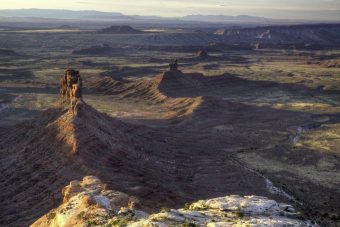
On December 4, President Donald Trump announced plans to drastically reduce the size of two national monuments in Utah.
“Some people think the natural resources of Utah should be controlled by a small handful of very distant bureaucrats located in Washington,” Trump said during the announcement, according to the New York Times. “And guess what? They’re wrong.”
Trump’s plan will affect 1.1 million acres of land at the Bear Ears monument and 800,000 acres at the Grand Staircase-Escalante monument. That acreage accounts for 85 percent and 45 percent of the monuments’ total land area, respectively.
Both monuments are currently protected under the Antiquities Act, which was established in 1906 as a means of preserving federal lands with particular natural, cultural, or scientific merit. The Antiquities Act is typically used to protect areas with particular significance to native nations, as is the case with both sites affected by Trump’s plans.
Grand Staircase-Escalante is also a notable site in terms of paleontology. The monument is a hotspot for dinosaur fossils, and 21 species have been discovered in the area.
In April 2017, Trump commissioned a report on national monuments that were designated as such in the past 20 years. Interior Secretary Ryan Zinke shared his findings with the president in August.
He recommended that Trump change the boundaries of a total of six sites, as well as consider creating three new monuments. He also suggested that Trump modify the list of approved activities on the currently protected lands.
This list determines which activities are allowed within each monument’s borders. For example, new mining and drilling projects are currently prohibited at Bears Ears, but the interior department is permitted to issue leases for cattle grazing. Cattle grazing is prohibited at Grand Staircase-Escalante, however.
The current president has made no secret of his intention to support the fossil fuel industry despite clear evidence of its negative impact on the environment. Zinke’s report claims Grand Staircase-Escalante alone contains “an estimated several billion tons of coal and large oil deposits,” and removing protections would enable the government to lease or even sell this land or its resources to private companies for new projects.
When President Bill Clinton gave Grand Staircase-Escalante national monument status in 1996, plans for a coal mining project were halted, so that project could be revisited if the size of the monument is successfully reduced or the approved activities list revised. Companies could also make deals to drill for oil on the land and establish pipelines, which opens up the potential for environmentally devastating leaks and spills.
However, Trump’s announcement is just the beginning of the process. The decision has been met by backlash due to its potential cultural and environmental consequences, and various lawsuits have already been submitted in an attempt to block the change.
However it plays out, this situation will set an important precedent with regards to national monuments. If Trump’s plan is successful, future presidents will be able to make similar reductions to other protected spaces. If blocked in court, the reverse will be true, and lands designated as national monuments will be untouchable by future leaders.
Source: futurism



